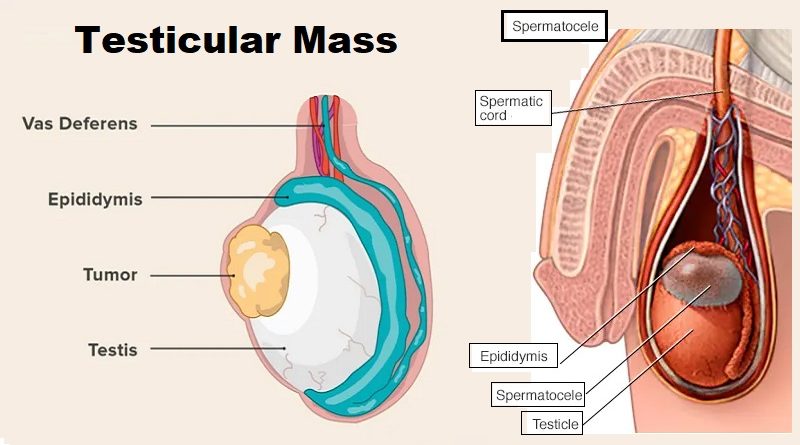Testicular Mass: What You Need to Know
One of the frequently asked questions revolves around Testicular Mass, (the presence of a lump on or near the testicle). Is it a benign condition, cancer or a simple issue? Firstly, I would like to clarify that most of the lumps that appear around the testicles are not harmful, however, some of them can be a sign of a serious medical condition. Therefore, you must not to panic, just consider the matter seriously. If you have a lump in your testicle, it’ i’s necessary to monitor and note the following points: Is there pain? Do you feel tenderness when touching the testicle? Do you have fever? Does the size of the lump increase over time?
Introduction
A lump or swelling in the testicles, or Testicular Mass, can be a cause of concern for many men. However, most lumps in the testicles are benign and not a type of cancer. In this article, we discuss the various possible causes of a testicular mass, the importance of self-examination, when to seek medical advice, and an overview of diagnosis and treatment.
Self-Examination of the Testicles
Self-examination is the best way to detect the presence of a testicular mass early. It is recommended to do a self-examination once a month after puberty. The best time to do the self-examination is when your body is warm and in a relaxed position.
Steps to Conduct a Self-Examination of the Testicles:
- Stand in front of a mirror and look for any swelling of the skin on the testicles.
- Place the first two fingers of each hand under the testicle with the thumb on top of the testicle.
- Gently move each testicle between the fingers and thumb to check for any lumps.
When to Seek Medical Advice
If you find a lump in your testicles, it is important to seek medical advice as soon as possible. A doctor can help determine the cause and provide the necessary treatment if needed. Some of the common causes of a lump in the testicles include a cyst, varicocele, orchiocele, testicular torsion, epididymitis, and testicular cancer.
Possible Causes of a Testicular Mass
- Cyst: A testicular cyst is a fluid-filled sac that can feel like a small, hard lump when touched. They are usually harmless and painless.
- Varicocele: A varicocele is swelling of the veins in the testicles, causing a lump or group of lumps around the testicle. The cause of a varicocele is not known, but there are theories about its causes.
- Orchiocele: An orchiocele is a collection of fluid around the testicle that causes the formation of a tumor known as a hydrocele. The most common cause of a hydrocele is an injury to the testicle or the area around it.
- Testicular Torsion: Testicular torsion is a medical emergency that occurs when the rope connected to the testicles twists, cutting off the blood supply. The primary symptom is severe, intolerable pain and swelling of the testicle.
- Epididymitis: Epididymitis is an infection of the epididymis, a tube located behind the testicle that stores and carries sperm. It can cause pain, tenderness, warmth, and swelling in the epididymis.
- Testicular Cancer: Swelling can be one of the first symptoms of testicular cancer, which is the most serious cause of a testicular mass. Testicular tumors usually do not cause pain, but they may be accompanied by other symptoms such as a heavy feeling in the scrotum, discomfort, and tenderness.
| Condition | Description | Symptoms |
|---|---|---|
| Testicular Cyst | A fluid-filled sac that feels like a small, hard lump | Harmless and painless |
| Varicocele | Swelling of veins in testicles causing a lump or group of lumps | Unknown cause |
| Orchiocele | Collection of fluid around testicle forming a hydrocele | Most common cause is injury |
| Testicular Torsion | Twisting of rope connected to testicles cutting off blood supply | Severe, intolerable pain and swelling of the testicle |
| Epididymitis | Infection of epididymis, a tube behind testicle | Pain, tenderness, warmth, and swelling in epididymis |
| Testicular Cancer | Swelling can be first symptom of testicular cancer | Usually no pain, but accompanied by other symptoms such as heavy feeling in scrotum, discomfort, and tenderness |
Diagnosis of Testicular Mass
The diagnosis of a testicular mass involves a thorough physical examination by a doctor and additional diagnostic tests may be required. Tests may include scrotal ultrasound, testicular biopsy, and blood tests.
- Physical Examination
The first step in diagnosing a testicular mass is a physical examination. The physician will feel the testicles and the surrounding area to determine the size, shape, and consistency of the mass. They may also check for any signs of pain, tenderness, or swelling. If a mass is identified, the physician may perform a scrotal ultrasound to get a better understanding of the structure and contents of the mass.
- Scrotal Ultrasound
A scrotal ultrasound is a non-invasive diagnostic test that uses high-frequency sound waves to create an image of the inside of the testicles. The ultrasound can help determine the size, location, and consistency of the mass. It can also help distinguish between a solid mass and a fluid-filled cyst.
- Testicular Biopsy
In some cases, a biopsy may be needed to determine if a testicular mass is cancerous or benign. During a biopsy, a small sample of tissue is removed from the mass and examined under a microscope. A biopsy is typically performed using a local anesthetic and can be done on an outpatient basis.
- Blood Tests
Blood tests may also be performed to help diagnose a testicular mass. The physician may order a serum tumor marker test, which measures the level of specific proteins in the blood that are associated with testicular cancer. Other blood tests, such as a complete blood count (CBC) and liver and kidney function tests, may also be performed to determine the overall health of the patient.
Treatment of Testicular Mass
- monitoring: In some cases of a testicular mass, you have to observe and monitor the mass progress, as these masses often resolve on their own.
- Hormonal Therapy: It may be necessary for individuals with conditions such as Klinefelter syndrome, which can lead to the development of testicular masses.
- Surgery: Surgical removal of the testicular mass is the primary treatment option for testicular cancer. This procedure is called an orchiectomy.
- Chemotherapy: In advanced cases of testicular cancer, chemotherapy may be necessary to shrink the size of the tumor and prevent the spread of cancer cells to other parts of the body.
- Radiation Therapy: In rare cases, radiation therapy may be required as an adjuvant treatment after surgery to destroy the remaining cancer cells.
SUMMARY
A testicular mass can have many causes, most cases are benign, but some others are serious. Self-examination is the best way to detect the presence of a testicular mass early, and seeking medical advice as soon as you can.
SOURCES
- Scrotal masses – Symptoms and causes – Mayo Clinic
- https://www.mayoclinic.org/diseases-conditions/testicular-cancer/diagnosis-treatment/drc-20353043
- https://www.cancer.org/cancer/testicular-cancer/detection-diagnosis-staging/diagnosis.html
- National Cancer Institute: https://www.cancer.gov/types/testicular/patient/testicular-treatment-pdq
- American Urological Association: https://www.auanet.org/guidelines/testicular-cancer-(adult)
- Testicular Cancer Society: https://testicularcancersociety.org/testicular-cancer/




